
Photographing Nature with a Large Format Camera
by Dr. Robert Berdan
September 29, 2017

Sutherland creek waterfalls, Blanket Creek Prov. Park , BC 4 x5 Velvia, 210 mm lens, F32, 2 sec
In a recent photography workshop at Lake O'hara one of the photographers, Peter, brought along a large format camera. This brought back memories when I used a 4 x 5 camera for about 5 years. The reason I began shooting with this format was the incredible detail I saw in prints made with 4x5 negatives and slides. This inspired me to purchase and learn how to use a 4 x 5 camera. I would like to share some images and comment on the use of large format.
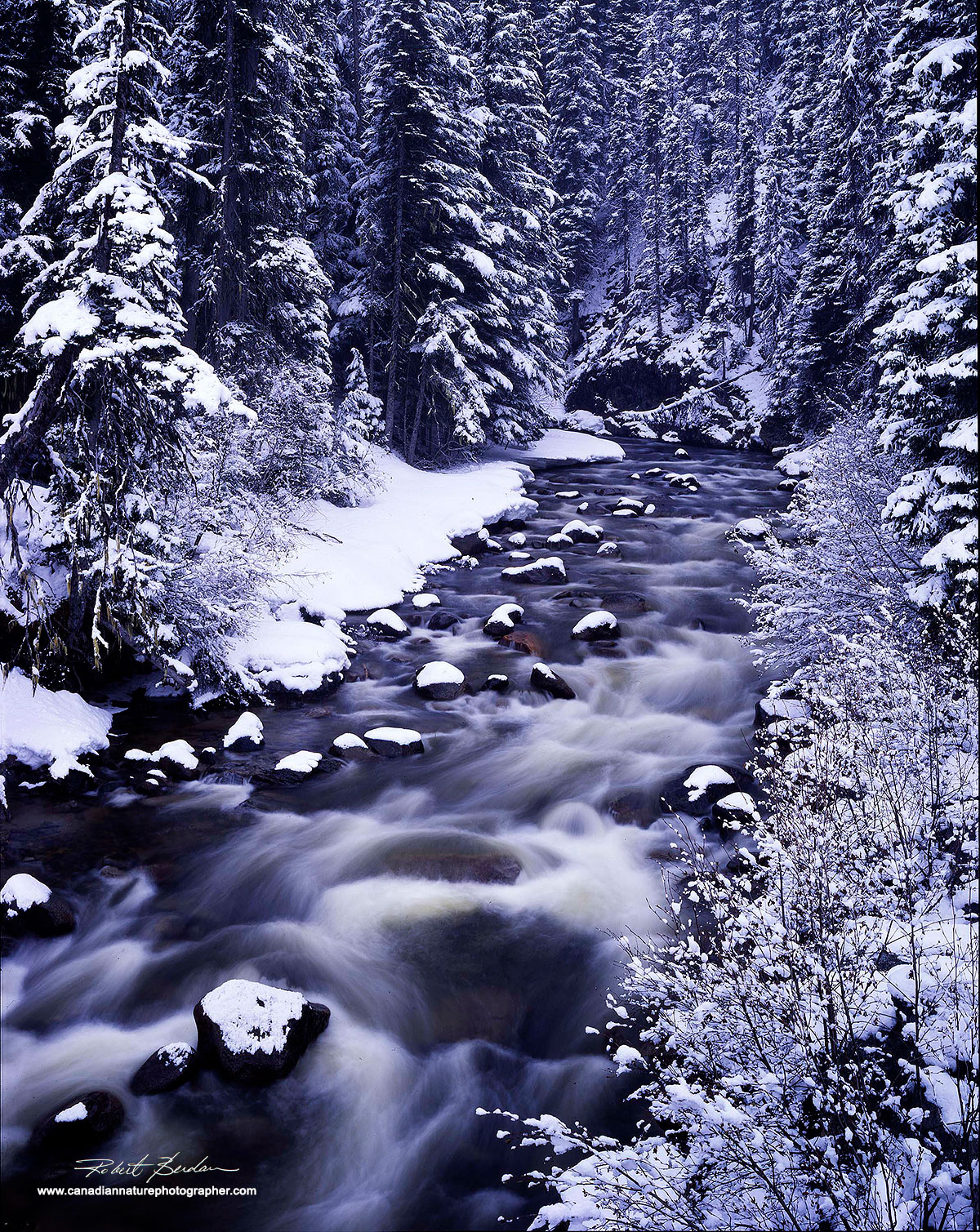
Whitecap creek, BC 135 mm F45 1 sec
I used the large format camera with Fuji Velvia 4x5 inch slide film which requires an accurate exposure determination and Velvia captures a narrow dynamic range of about 5-6 F-stops. Even after having 20 years experience with 35 mm photography, mastering the large format camera was hard. It sometimes took me 10-15 minutes to set the camera up and make an exposure. Determining exposure requires more then point and shoot, and I used a Pentax spot meter most of the time and sometimes an incident light meter. We have a spot meters in most of our DSLR cameras but most folks rarely use it. Using spot meter requires a good understanding of how different tones and colours affect exposure. I made lots of mistakes and ruined many sheets of film because I forgot to close the lens aperture before exposing the film. The whole process forces one to slow down and pay more attention to the image and helps you understand more about photography. The cost per image was between $5-7 depending on whether I loaded the film in a film holder or used ready load packets. Then it cost me another $5 to get each plate processed. I wrote down each exposure so I could learn from my mistakes and save money. With digital cameras the exposure information is embedded in an EXIF file you can read after so there is no real need to write down the exposure settings anymore. For 4x5 black and white shooters it's not as expensive and one can develop the film at home. In order to print my slides I then had to invest in a 4 x 5 enlarger and they are not cheap. I learned how to use black and white masks during printing from Keith Logan. The masks are used to control the contrast when printing Illfochrome in the darkroom similar to how we use the Shadow highlight tool in Photosho with digital images. Printing was also a time consuming task and one could spend the entire day making a single print.

My father and Giant Sitka Spruce in the Carmanah Valley, Vancouver Island. 135 mm F45 1 sec. Velvia.
One person I know processed their own 4x 5 slide film, but this can be risky and one has to keep tight control of the temperature and agitation during the process to avoid colour shifts. I choose to get my large format colour slides commercially processed for consistency.
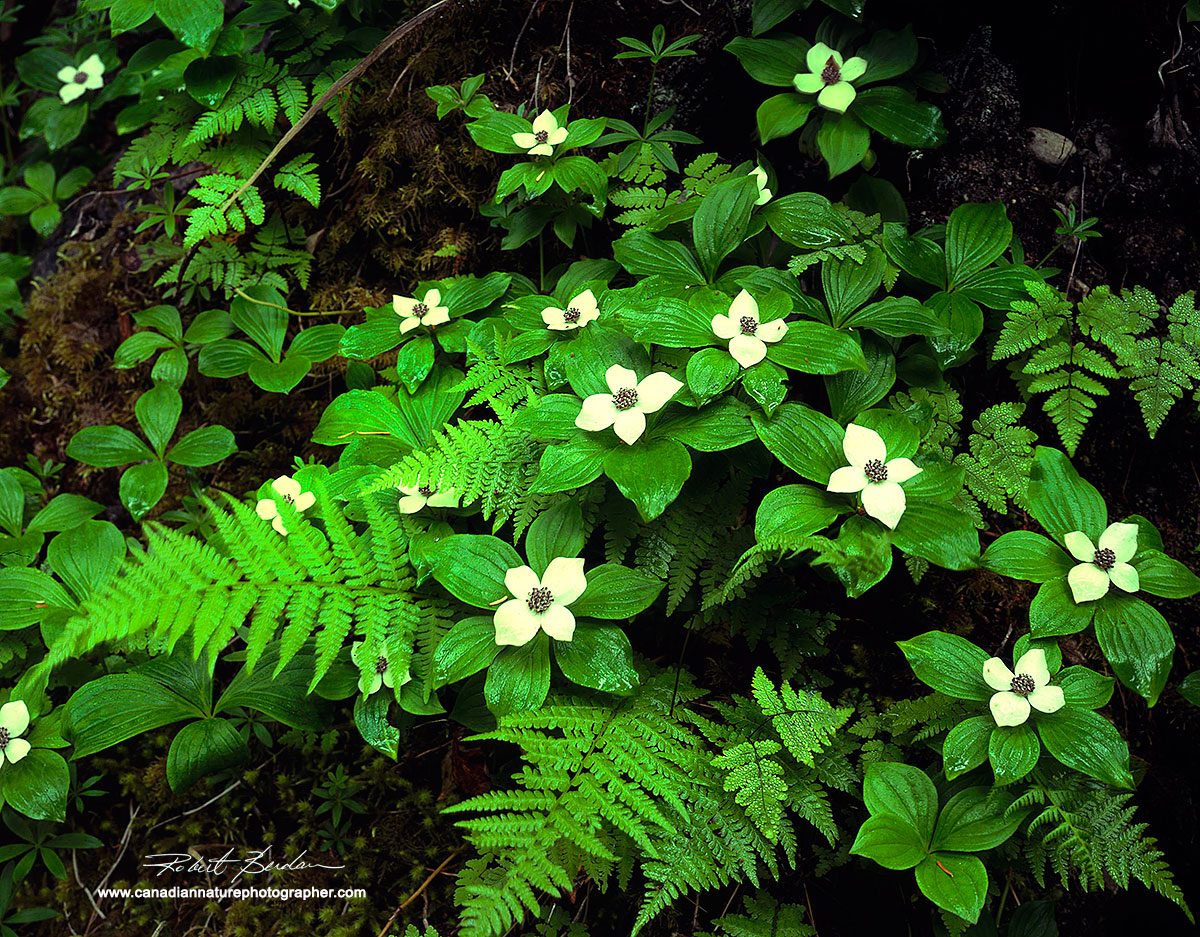
Bunchberry and ferns, Revelstoke, BC. 135 mm F45, 4 sec. Velvia

Fire weed in Banff National Park, AB
I had hoped a large format digital back would be offered for a reasonably price (i.e. under $7,000) but it seemed that this was never going to happen. Large format photography is not as popular as the smaller formats and there isn't a big market anymore. There are some digital backs and some photographers have migrated to medium format digital cameras, but the cost is very high - see references at the end. Today if I want a really high resolution image I take several overlapping images and combine them into a montage in Photoshop and there is no limit to how big one can go. Still when one puts a 4x5 slide on a light box and views the image with a loupe they are very impressive. After 5 years of shooting I only have about a 150 good images. The other thing that large format photographers must contend with is wind. Often exposures are several seconds long and the slightest breeze could cause the subjects to move and blur in the picture.
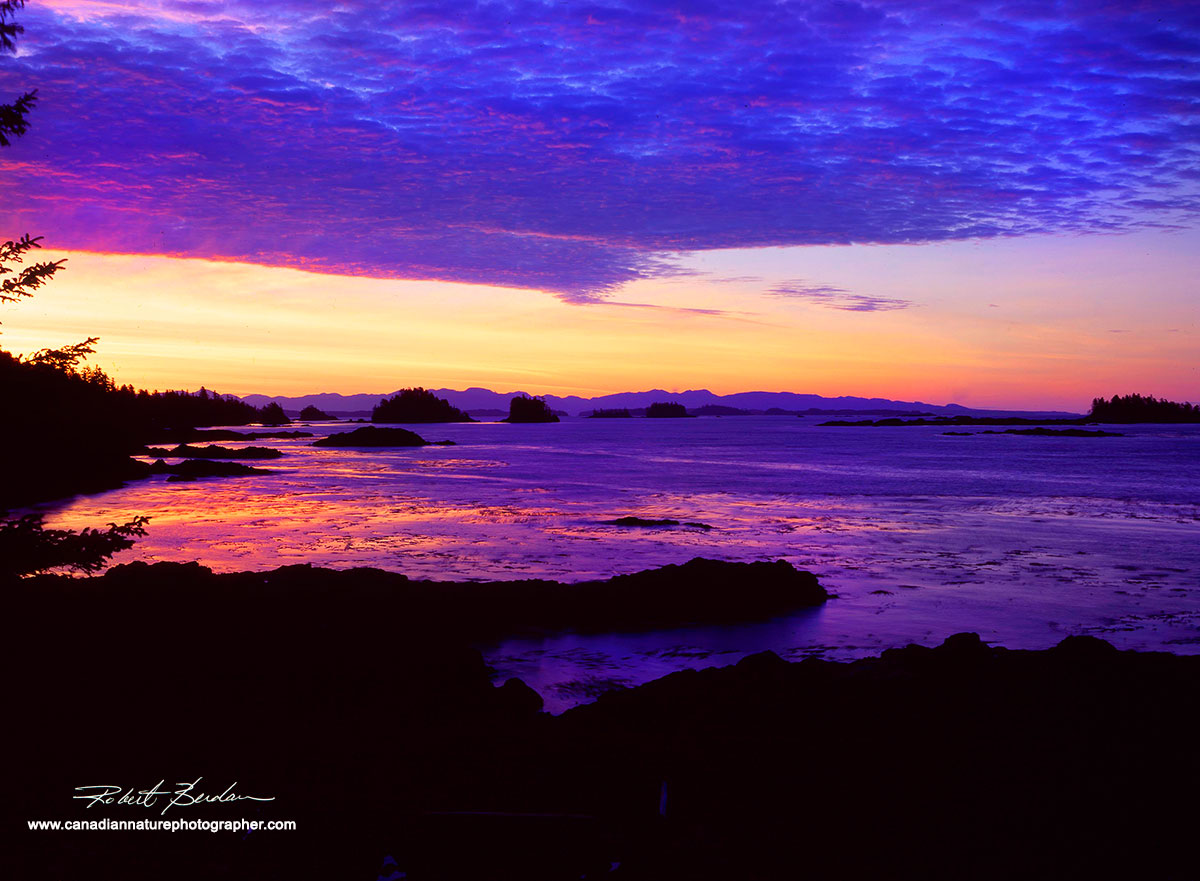
Broken Islands near Ucluelet, Vancouver Island, BC
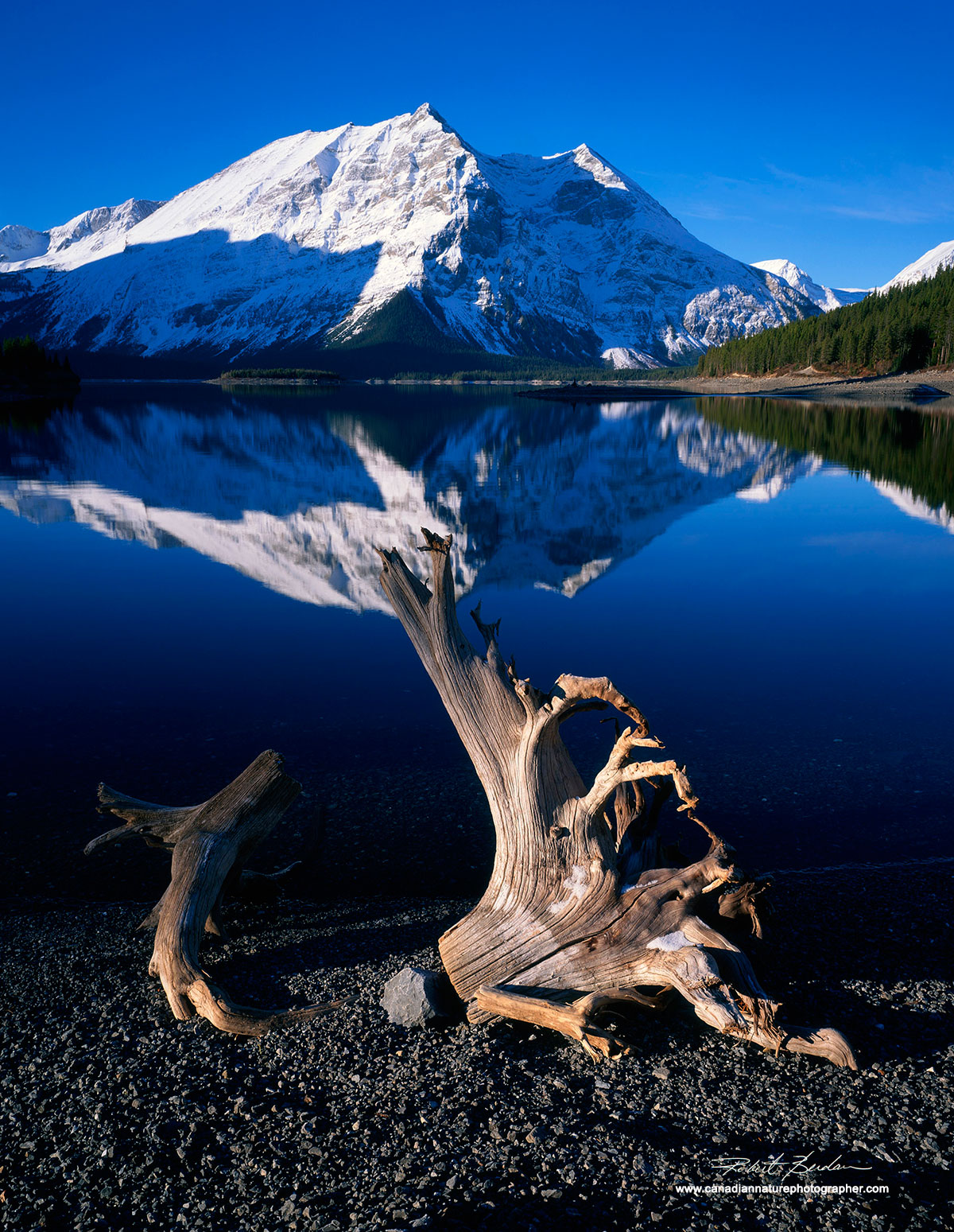
Mt. Lyautey, Upper Lake Kananaskis Provincial Park, AB
Large format photography forces a photographer to slow down and that's a good thing. The high cost per image means you don't take shots even after you set up if they don't look good. It also means that a higher percentage of shots taken tend to be good images - after all it takes a lot to time and effort to take a picture. For those that have the fortitude to shoot large format it can be very rewarding. I have tried to apply some of what I learned with a large format camera to taking pictures with my 35 mm camera. For one thing a tripod is essential for sharp pictures. I also found using a large format camera made me contemplate the scene before me more carefully. It also affected how I looked at a scene and I often searched for scenes with more complexity and detail because I knew they could be captured effectively.
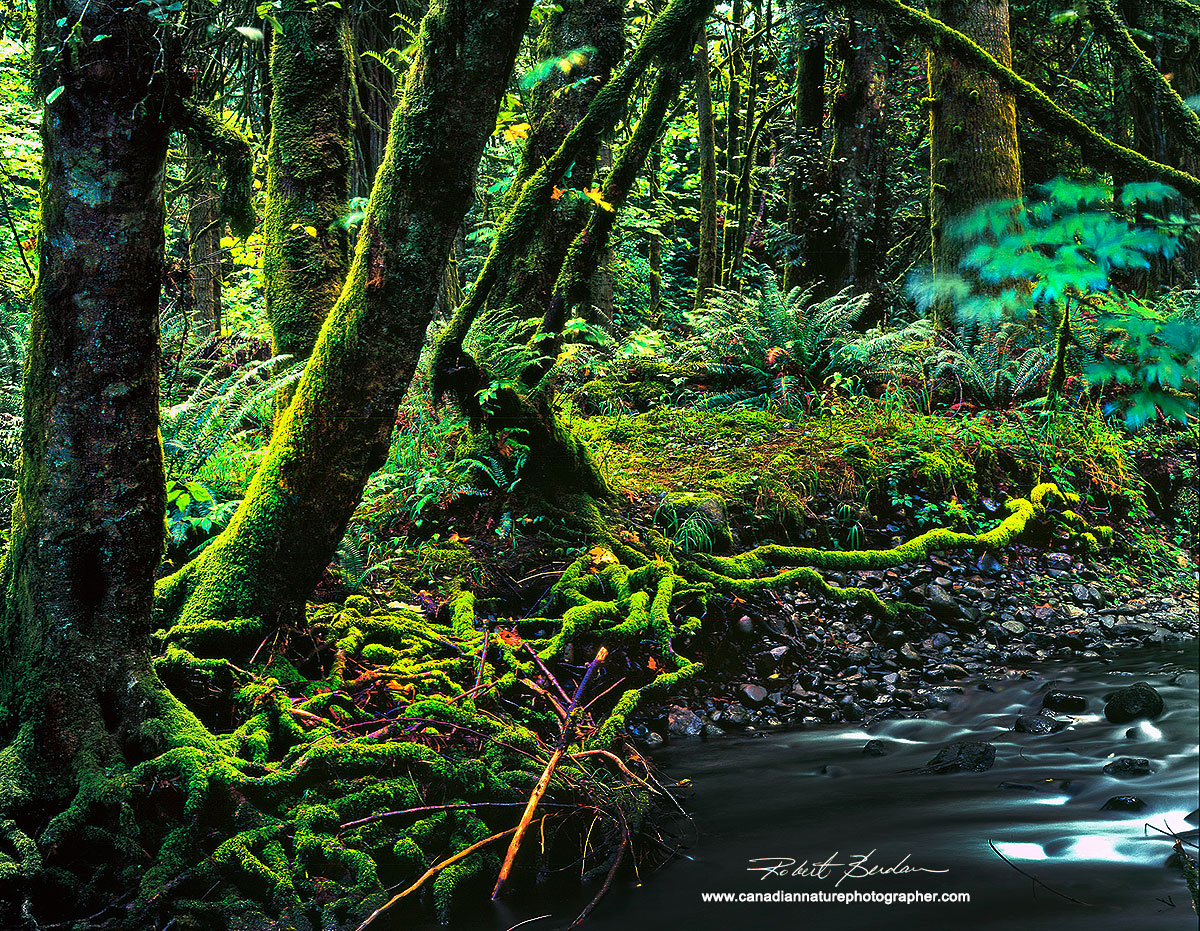
Goldstream Provincial Park, Vancouver Island, BC

Opabin Plateau, Lake O'hara, Yoho National Park, BC
The image in a large format camera is viewed on a glass screen under a dark cloth or fold out box. I used a slide loupe to focus carefully on the ground glass. The image also appears upside down and this can help from a compositional point of view as it forces one to look at the projected image objectively. By titling the front or back of the camera one could also increase the depth of field to a greater extent then in 35 mm. The lenses I owned included a: 90mm, 135 and 210 mm and I often used F45 to achieve a great depth of field. My exposures often ranged from 1\4 sec to 4 seconds, so often I had to wait for the wind to stop. I used the large format camera to photograph landscapes in nature, but a few photographers have been able to use the large format camera for birds and other wildlife. The large format camera is also extensively used in architecture and food photography because of the great depth of field and the ability to tilt and modify perspective. Large format images allow for enlargements even up to the size of billboards. When making very large prints the details that can be seen are remarkable. There are larger format cameras including an 8 x 10 inches and Panoramic cameras. These cameras can capture remarkable detail, but require perseverance and attention to detail. It's a slower pace and for some this is one aspect that attracts them to large format.

Point no Point, Vancouver Island.
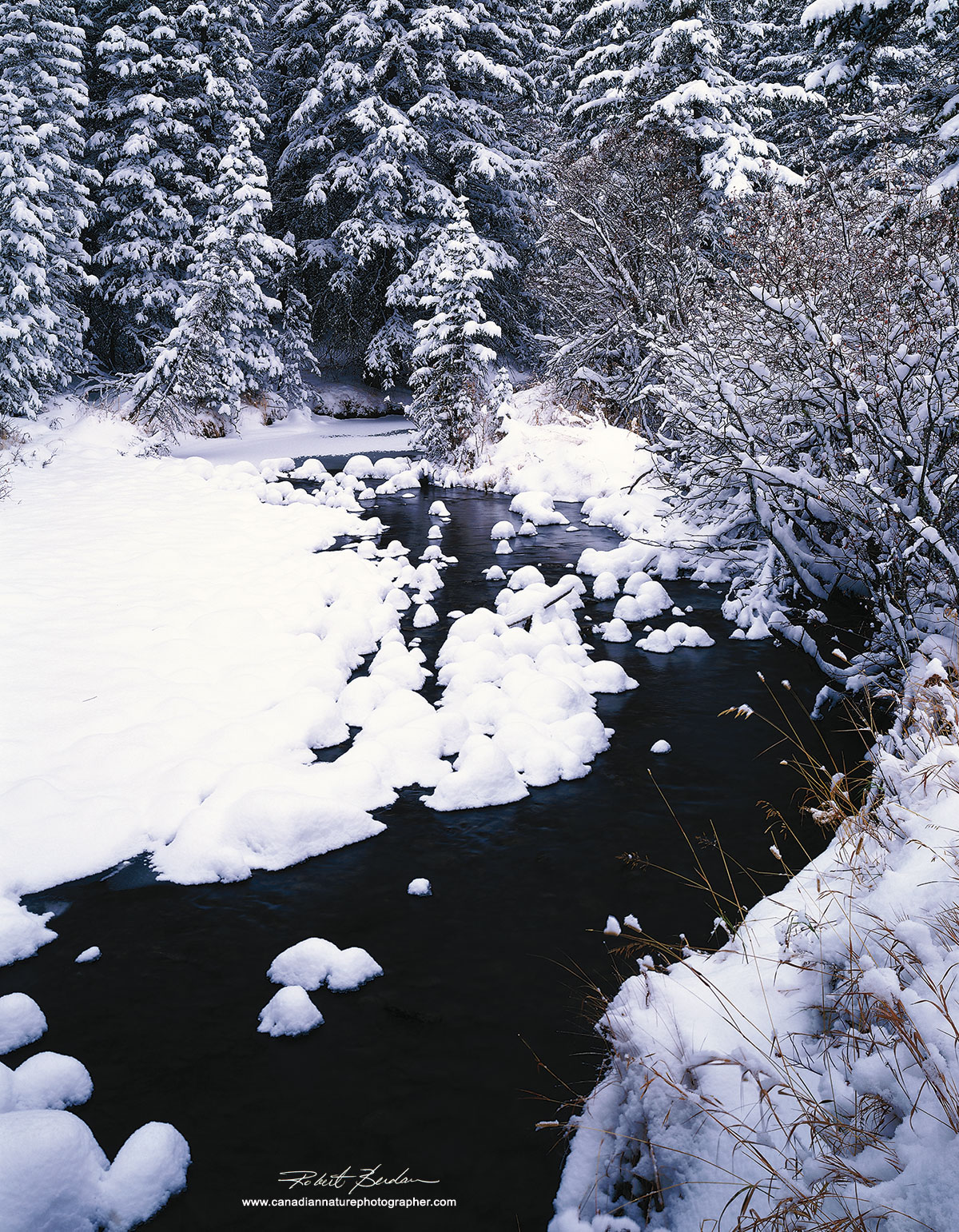
Dogpound Creek, AB
When I first saw some large format prints at a workshop I didn't want to show my prints made from 35 mm film. When looking at pine trees details like small needles were readily resolved and this impressed me - so I bought a Toyo 4 x 5 field camera and went about learning how to use it. A friend, Keith Logan photographed with a 4 x 5 for many years and after much coaxing I was able to get him to mentor me in learning to shoot with a 4x5 camera. I also read everything I could get my hands on, but having someone show you how to meter in backlight and setup the camera properly was very helpful. The best instructional book I read was "Large Format Nature Photography" by Jack Dykinga an award winning landscape photographer (see reference at the end). Other large format photographers whose work I admired included Eliot Porter who worked with both Black and white and colour. Ansel Adams whose books The Camera, The Print and The Negative were also very helpful understanding how a large format camera works.

Paradise creek, Banff National Park, AB

Kennedy river valley, Vancouver Island.
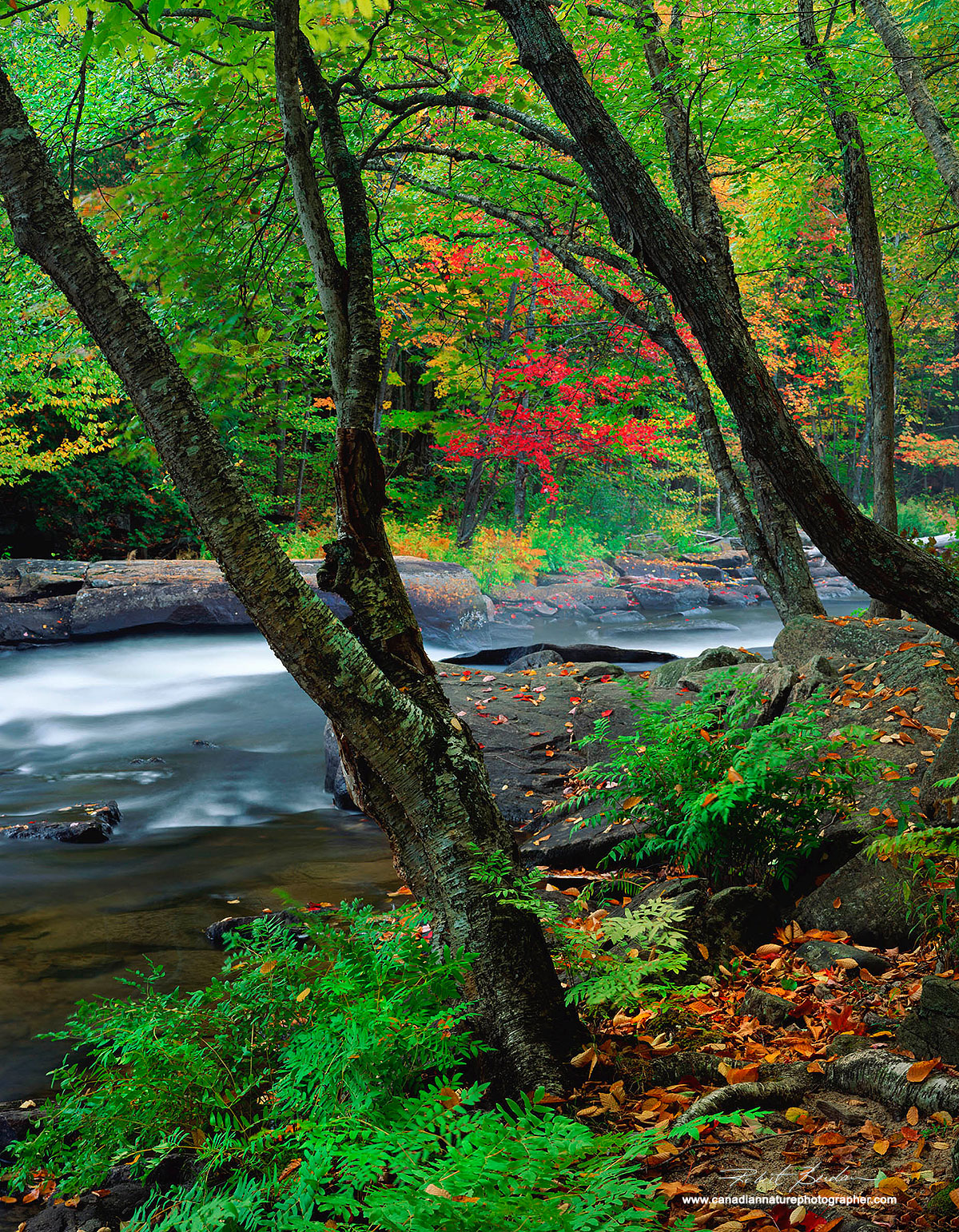
Oxtongue river, Ontario
Because 4x5 image captures so much detail I found my approach to composition changed. I looked more closely at textures and patterns and my pictures tended to be more complex. I was however, frustrated by the fact that I might only have 20 plates with me at a time. I started to carry a darkroom bag with me to load more plates, but still found I was wanting to take more pictures then the large format camera would permit. After 5 years I realized that shooting at such a slow pace was not going to work for me as I couldn't use the camera to capture birds in flight or other elusive wildlife. Still I found the experience of using a large format camera rewarding and I believe it helped me become a better photographer.
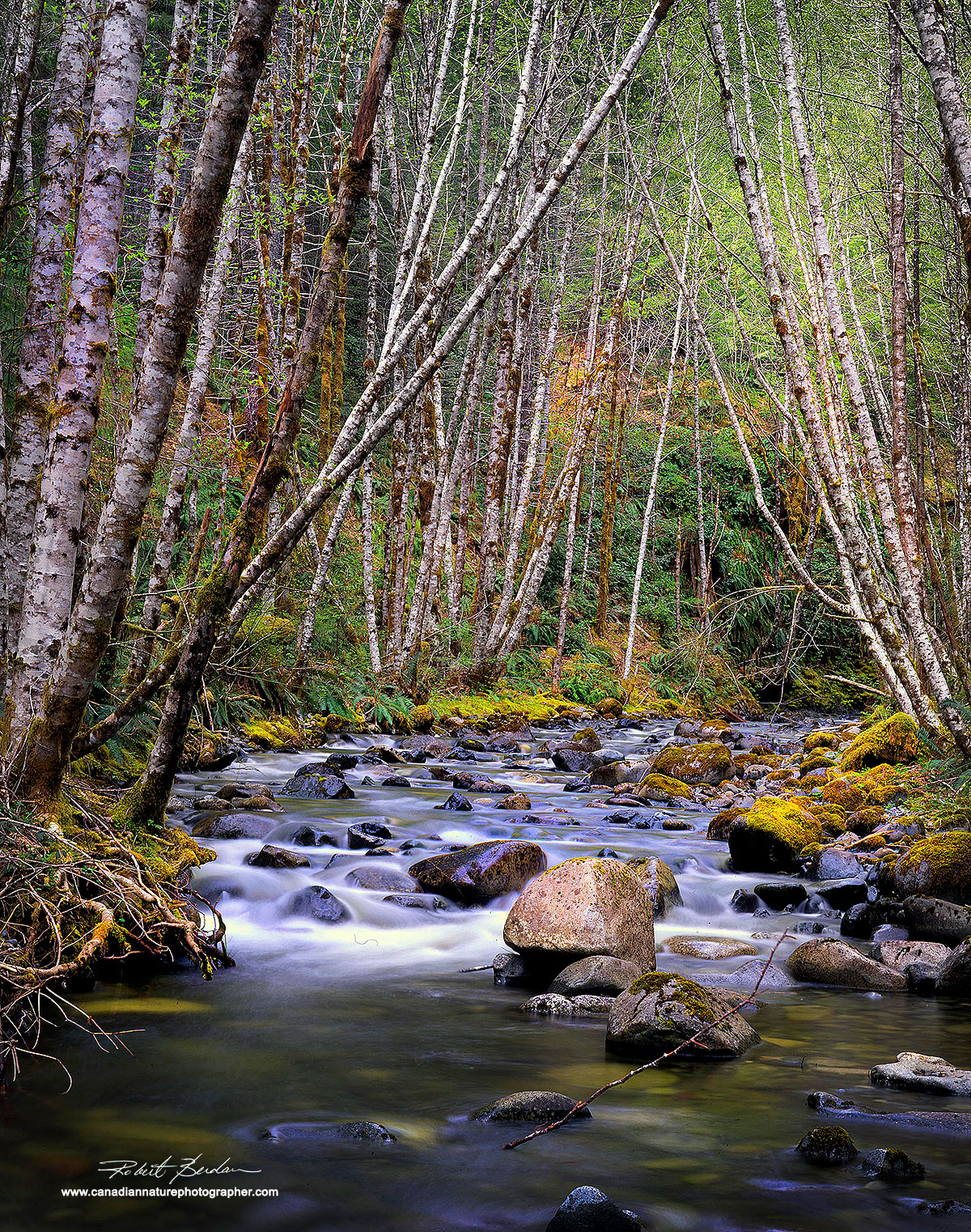
Alder trees, Vancouver Island, BC
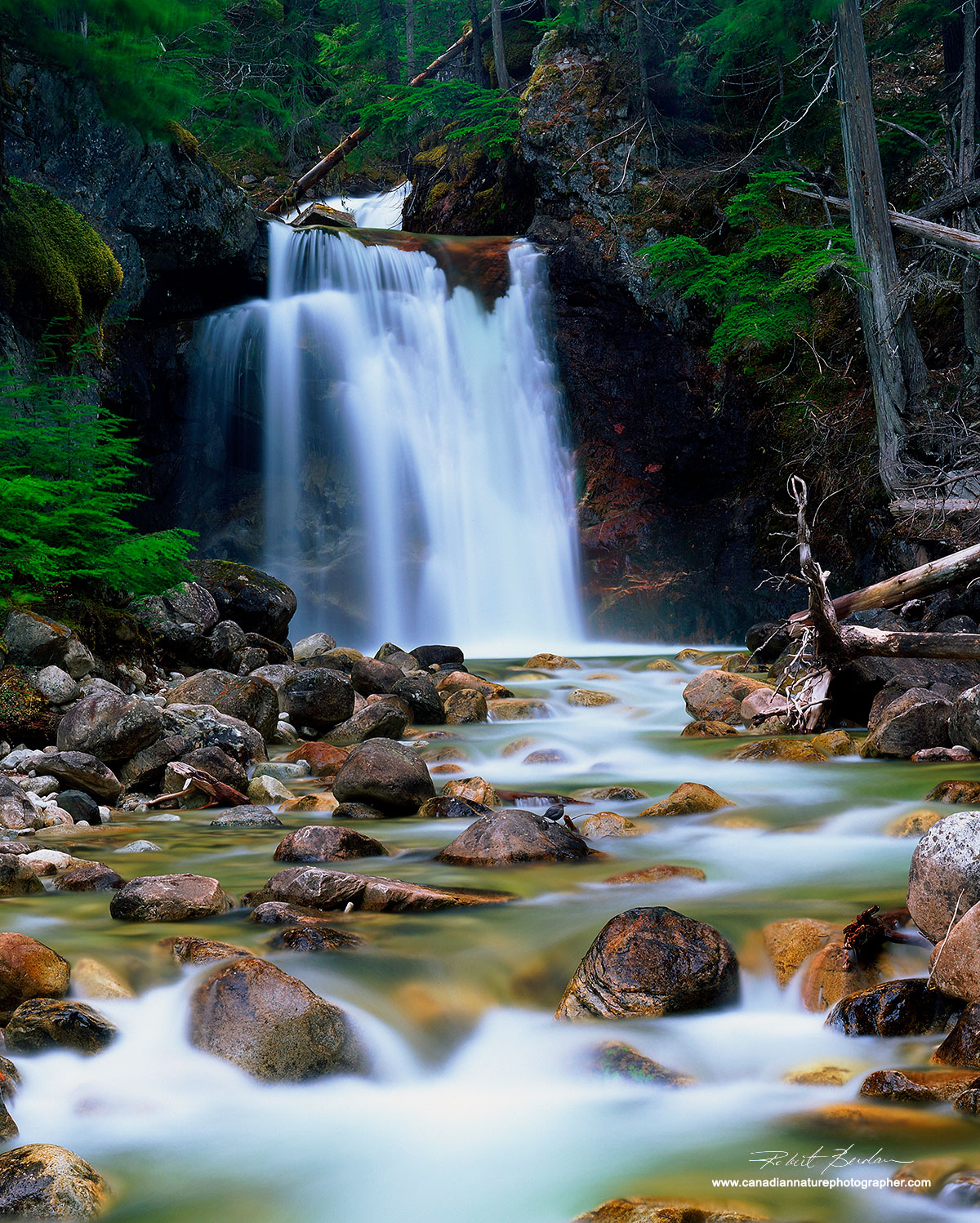
Gardner Creek waterfalls near Nakusp, BC. If you look closely there is a Dipper (small bird) sitting on the rock near the center of the picture and he held still for 4 secs while I exposed this shot. 135 mm F45 4 secs.
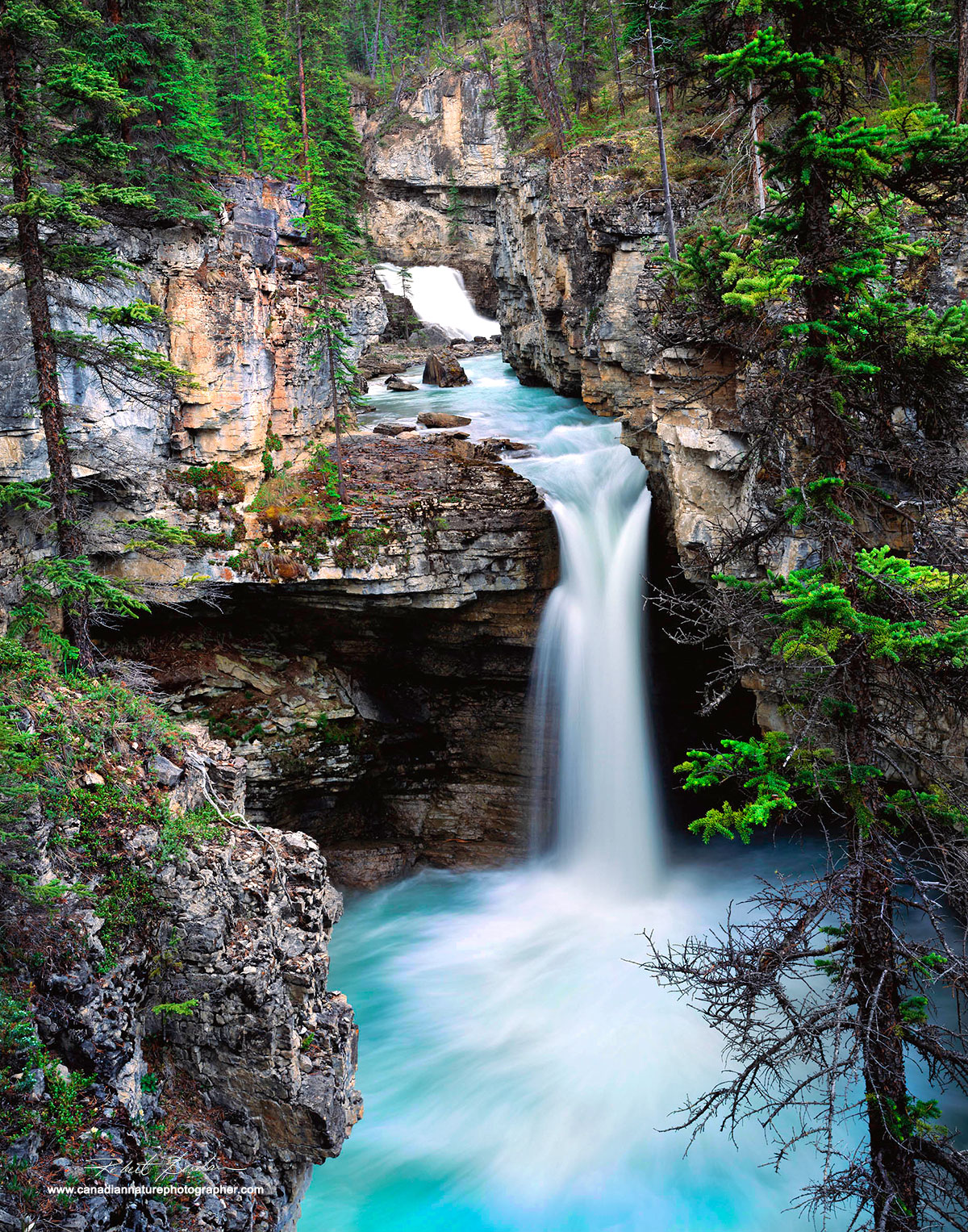
Beauty Creek, Banff National Park, AB
When digital photography began to become popular in 2000 and Epson produced the first archival digital ink printers I sold my 4x5 camera and darkroom equipment. It bothered me that I was essentially throwing away over 20 years of darkroom experience, though I believe working in a darkroom has helped me when using Photoshop. The greater resolution of 4x5 wasn't a factor anymore as I could combine images into a photomontage. I could simply take multiple digital images and then overlap them in Photoshop to create what ever size images I needed. Later cameras like the Nikon D800 boasted 36 Mega-pixels and also allowed huge enlargements. 35 mm film e.g. Velvia was equivalent to about 8 Mega-pixels, and the dynamic range of digital is so much greater then Velvia. As for depth of field, with digital I can take a shot focused on the foreground and one on the background and then combine the two images in Photoshop (Focus stack) to achieve even greater depth of field then a 4 x 5 camera can capture - so for me it was time to move on. I still smile when I see a large format photographer and frankly admire them for the time they take to set up and carefully compose the shot. I think that the process of slowing down and setting up the shots is one of the real benefits of large format photography. Sometimes big is better, but large format photography is not for everyone, but for those that choose to keep it alive you have my admiration. I wonder what other things the future of photography has in store and how they will affect how we record images. RB
References
Large Format Nature Photography by Jack Dykinga (2001) ISBN 0-8174-4157-3
4x5 Film vs. Digital - Luminous Landscape
Comparing the Image quality of Film and Digital - PetaPixel
The Real Resolution of film - interesting but he says 35 mm equivalent to 156 MP camera I think more like 8 MP
Digital Megapixel equivalent of Film by Roger Clark
View Camera Magazine for Large format cameras - online only no longer being published
Landscape Photography Magazine - view their spectacular cover shots
List of large format photography resources
Large format photography forum
Large format photography tutorials
Digital Large Format Photography
Authors Biography & Contact Information
 Robert Berdan is a professional nature photographer living in Calgary, AB specializing in nature, wildlife and science photography. Robert offers photo guiding and private instruction in all aspects of nature photography and Adobe Photoshop training.
Robert Berdan is a professional nature photographer living in Calgary, AB specializing in nature, wildlife and science photography. Robert offers photo guiding and private instruction in all aspects of nature photography and Adobe Photoshop training.
Email at: rberdan@scienceandart.org
Web site: www.canadiannaturephotographer.com
Phone: MST 9am -7 pm (403) 247-2457.
Click on the buttons below and share this site with your friends